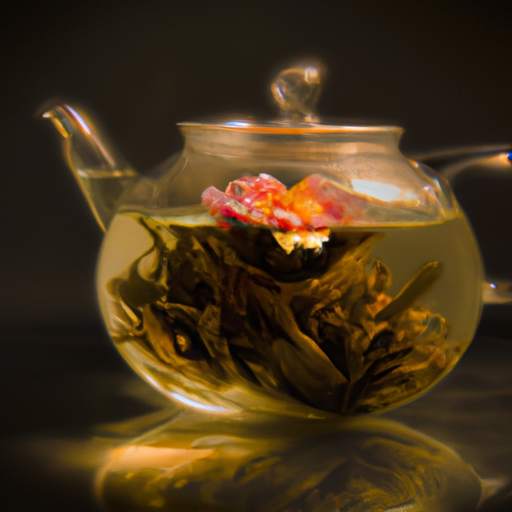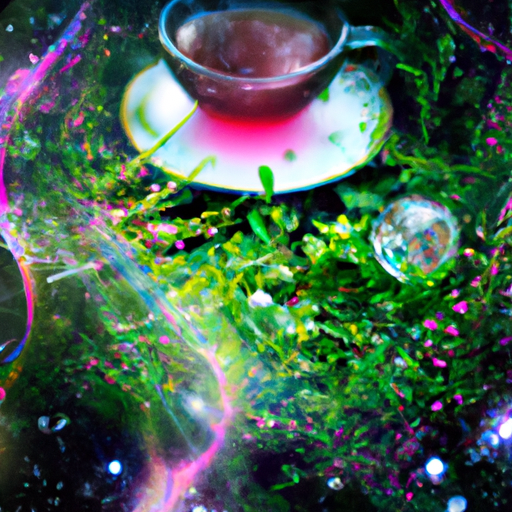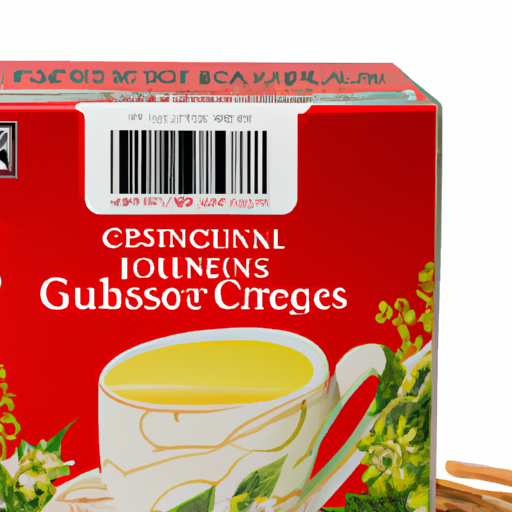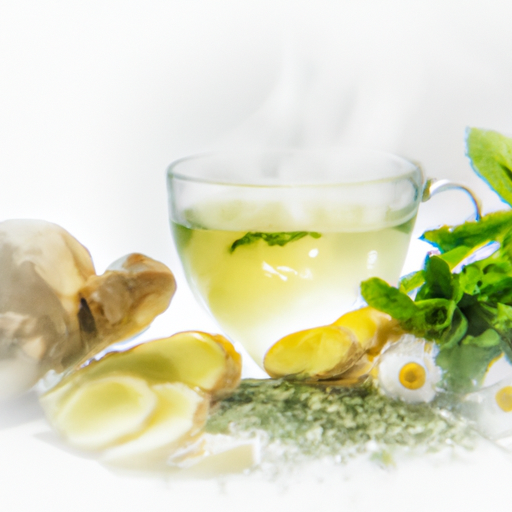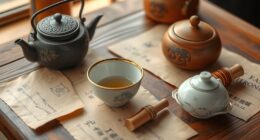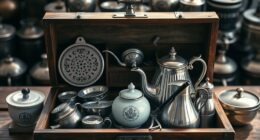I felt lost and uncertain when my doctor informed me that I could no longer have coffee or any form of caffeine. It was like being a ship without its anchor, unsure of how to face my mornings without that beloved energy boost.
Thankfully, I discovered a world of herbal teas that not only satisfy my cravings but also offer a myriad of health benefits. These teas, free from caffeine’s grasp, have become my new companions in the quest for a flavorful and invigorating start to my day.
From the soothing Chamomile tea to the refreshing Peppermint tea, there is a herbal infusion out there for every taste bud. So, if you too find yourself in caffeine exile and seeking a warm cup of comfort, join me as we explore the wonderful world of herbal teas that are sure to awaken your senses and nourish your body.
Key Takeaways
- Chamomile tea is a good herbal tea to start drinking as it promotes relaxation and reduces anxiety, and has anti-inflammatory properties.
- Peppermint tea is another suitable option as it aids digestion and relieves stomach discomfort.
- Rooibos tea is caffeine-free, rich in antioxidants, and supports digestive health.
- Hibiscus tea is high in antioxidants, lowers blood pressure and cholesterol, and boosts the immune system.
Chamomile Tea
If you can’t have caffeine, why not try chamomile tea? Chamomile tea is a delicious and soothing herbal tea that’s been enjoyed for centuries.
Not only does it taste great, but it also offers a wide range of health benefits. One of the main health benefits of chamomile tea is its ability to promote relaxation and reduce anxiety. It contains compounds that bind to certain receptors in the brain, which can help calm the nervous system and promote a sense of calmness. This makes it the perfect beverage to enjoy before bed to help you unwind and get a good night’s sleep.
In addition to its calming effects, chamomile tea also has anti-inflammatory properties. It can help reduce inflammation in the body, which can be beneficial for people with conditions such as arthritis or inflammatory bowel disease.
To properly brew chamomile tea, start by boiling water and then pour it over a chamomile tea bag or loose chamomile flowers. Let it steep for about 5 minutes to allow the flavors to infuse into the water. You can also add a touch of honey or lemon juice for added flavor if desired.
Now, let’s move on to the next section about peppermint tea and its health benefits.
Peppermint Tea
Peppermint tea is a breath of fresh air, offering a refreshing and invigorating alternative to traditional caffeinated beverages. Not only does it have a delightful taste, but it also provides numerous health benefits.
Peppermint tea is known for its ability to aid digestion and relieve stomach discomfort. It can help alleviate symptoms of indigestion, bloating, and gas. Additionally, peppermint tea has a soothing effect on the mind and body, making it an ideal choice for those looking to unwind and relax.
To make the perfect cup of peppermint tea, start by boiling water and pouring it over a peppermint tea bag or a handful of fresh peppermint leaves. Let it steep for about 5 minutes to allow the flavors to fully infuse into the water. You can add a touch of honey or a squeeze of lemon for some extra flavor if desired. Once it’s ready, sit back, and enjoy the invigorating aroma and taste.
Now, let’s transition to the next section about rooibos tea, which is another wonderful herbal tea option.
Rooibos Tea
Known for its rich and earthy flavor, rooibos tea offers a delightful and caffeine-free alternative for tea enthusiasts. Made from the leaves of the Aspalathus linearis plant, which is native to South Africa, rooibos tea has gained popularity for its health benefits and distinct taste.
One of the main advantages of rooibos tea is that it’s completely caffeine-free, making it an ideal choice for those who need to avoid caffeine due to medical reasons. This tea is also rich in antioxidants, such as aspalathin and nothofagin, which help protect the body against damage from free radicals.
Additionally, rooibos tea is known for its anti-inflammatory properties and can potentially improve heart health by lowering blood pressure and cholesterol levels.
Another benefit of rooibos tea is its potential to support digestive health. It has been shown to relieve common digestive issues such as indigestion, stomach cramps, and diarrhea. Moreover, rooibos tea contains several minerals, including calcium, magnesium, and manganese, which are important for maintaining strong bones and teeth.
Transitioning into the subsequent section about hibiscus tea, this vibrant and tangy herbal tea is a perfect choice for those looking for a refreshing caffeine-free option.
Hibiscus Tea
When you want to explore new flavors and experience a refreshing twist, hibiscus tea is the perfect choice for you. Not only does it offer a vibrant and tangy taste, but it also comes with a plethora of health benefits.
Hibiscus tea is known for its high levels of antioxidants, which help fight inflammation and protect against chronic diseases. It’s also believed to lower blood pressure and cholesterol levels, making it a heart-healthy option. Additionally, hibiscus tea is rich in vitamin C and minerals like iron, making it a great choice to boost your immune system and support overall well-being.
In terms of recipes, hibiscus tea can be enjoyed both hot and cold. For a refreshing iced tea, simply brew a strong batch of hibiscus tea, let it cool, and add ice cubes and a squeeze of lemon or lime. If you prefer a warm cup, steep a hibiscus tea bag in hot water for a few minutes, then sweeten with honey or agave syrup to taste. The possibilities are endless, and you can even experiment with adding other flavors like mint or ginger for an extra kick.
Now, let’s move on to the next exciting herbal tea: ginger tea.
Ginger Tea
If you’re looking to add a little spice to your tea collection, ginger tea is the perfect choice for a flavorful and invigorating experience. Not only does ginger tea have a delicious taste, but it also offers numerous health benefits. Ginger has been used for centuries for its medicinal properties, and ginger tea allows you to enjoy these benefits in a warm and soothing beverage.
One of the main benefits of ginger tea is its ability to aid digestion. It can help alleviate symptoms of indigestion, such as bloating and stomach discomfort. Ginger tea can also help relieve nausea, making it a great option for those experiencing morning sickness or motion sickness.
To make ginger tea, start by peeling and slicing fresh ginger root. Boil water and add the ginger slices, allowing it to simmer for about 10-15 minutes. You can also add honey or lemon for added flavor. Strain the tea before serving and enjoy!
Now, let’s move on to the next herbal tea option: lemon balm tea. It has its own unique benefits and flavors that make it a wonderful addition to your tea rotation.
Lemon Balm Tea
Lemon Balm Tea is a delightful herbal tea option that I highly recommend. It has a pleasant citrusy flavor that brings a refreshing twist to your tea routine. Not only does it taste great, but it also has calming properties that can help reduce anxiety and promote relaxation.
So, if you’re looking for a soothing and caffeine-free beverage, try adding Lemon Balm Tea to your tea collection.
Citrusy and calming flavor
To add a citrusy and calming flavor to your tea routine, try sipping on a blend of chamomile and orange peel. Citrus fruits are known for their numerous health benefits, and when infused in herbal teas, they can provide an extra boost of goodness.
Chamomile is renowned for its relaxation properties, while orange peel adds a refreshing and tangy taste to the tea. Additionally, orange peel is a great source of vitamin C, which can help boost your immune system. This citrusy blend is perfect for those looking to unwind and reduce stress.
The combination of chamomile and orange peel creates a soothing experience that can promote relaxation and reduce anxiety. Transitioning into the next section, let’s explore a tea blend that specifically focuses on reducing anxiety and promoting relaxation.
Reduces anxiety and promotes relaxation
Indulge in this exquisite blend of chamomile and orange peel tea, which will create a serene and tranquil atmosphere, allowing you to effortlessly unwind and alleviate any signs of anxiety or stress. Chamomile has been used for centuries as a natural remedy for promoting relaxation and reducing anxiety. Combined with the refreshing citrus flavor of orange peel, this herbal tea provides the perfect combination to calm your mind and soothe your nerves.
To further enhance the relaxation benefits of this tea, you can incorporate meditation techniques for anxiety reduction. Find a quiet space, close your eyes, and focus on your breath. Practice deep breathing exercises to promote relaxation and create a sense of inner peace.
Transitioning to the subsequent section about ‘green tea (decaffeinated)’, you can continue your journey to find a suitable herbal alternative to coffee.
Green Tea (decaffeinated)
If you’re looking for a caffeine-free alternative to coffee, you might want to consider giving decaffeinated green tea a try. Green tea is known for its numerous health benefits, and opting for the decaffeinated version allows you to enjoy these benefits without the stimulating effects of caffeine.
Green tea is packed with antioxidants, which help to protect the body against free radicals and reduce the risk of chronic diseases. It also contains a compound called L-theanine, which promotes relaxation and reduces anxiety. This makes it an excellent choice for those looking to unwind and find a moment of calm in their day.
When comparing green tea to black tea, green tea generally contains less caffeine. This can be beneficial for individuals who are sensitive to caffeine or have been advised to limit their intake. Additionally, green tea has a milder and more delicate flavor compared to black tea, making it a refreshing and enjoyable beverage to sip on throughout the day.
Decaffeinated green tea can be found in most grocery stores and specialty tea shops. It can be brewed just like regular green tea, using hot water and steeping for a few minutes. So if you’re looking for a coffee substitute that offers health benefits and a soothing experience, give decaffeinated green tea a try.
Frequently Asked Questions
Are herbal teas safe to consume if I have certain medical conditions or take medication?
Herbal teas can be safe to consume, but it’s important to consult with your doctor or pharmacist if you have certain medical conditions or take medication. Herbal tea alternatives for coffee lovers can offer various benefits for overall health.
How long should I steep herbal tea for maximum flavor and benefits?
For maximum flavor and benefits, steep herbal teas for 5-7 minutes. Enhance the taste by adding honey or lemon. Combining different herbs can create unique flavors and increase the health benefits. Enjoy!
Can herbal teas help with digestion or other common health issues?
Herbal teas can be beneficial for digestion and common health issues. Some herbal teas, such as chamomile or peppermint, can help with digestion. For better sleep, try herbal teas like lavender or valerian. For stress relief, consider teas like chamomile or lemon balm.
Are there any potential side effects or interactions to be aware of when drinking herbal teas?
When it comes to herbal teas, it’s important to be aware of potential side effects. However, with the right choice and moderation, they can be a wonderful addition to your routine.
Can herbal teas be consumed by pregnant or breastfeeding women?
Yes, herbal teas can generally be consumed by pregnant or breastfeeding women. Some herbal teas can even help with milk production. The best herbal teas for calming and relaxation during pregnancy include chamomile, lavender, and lemon balm.
Conclusion
In conclusion, finding a suitable herbal tea to replace coffee can be a comforting journey. Just like a warm blanket on a chilly day, chamomile tea provides a soothing and calming effect.
Peppermint tea, with its refreshing minty taste, is like a breath of fresh air on a sunny morning.
Rooibos tea, with its rich and earthy flavor, is like taking a peaceful walk through a forest.
Hibiscus tea, with its vibrant color and tangy taste, is like sipping a tropical sunset.
Ginger tea, with its spicy kick, is like a warm hug from a loved one.
Lemon balm tea, with its citrusy aroma, is like a ray of sunshine on a cloudy day.
And for those who still crave a hint of green tea, the decaffeinated version offers a gentle and mellow sip, like a gentle breeze rustling through leaves.
So, embark on this delightful journey and discover the perfect herbal tea that will bring comfort and joy to your caffeine-free days.


